Evaluation and Lessons Learned from a Campus as a Living Lab Program to Promote Sustainable Practices
Abstract
1. Introduction
In 2014, The University of British Columbia (UBC) approved a 20 Year Sustainability Strategy, which covered a wide spectrum of university activities including an enhanced focus on developing research within and outside the university involving strategic partnerships with industry and government, a renewed focus on university operations and infrastructure through the lens of the living lab to accompany UBC’s goal of eliminating greenhouse gas emissions by 2050, and within teaching and learning, a renewed institutional commitment to embed sustainability learning across all undergraduate teaching programs by 2035 [5].
2. Background
2.1. Literature Review on Living Lab Organizations and Institutions of Higher Education (IHE)
2.2. History of Sustainability and the CLL Program at UBC
2.3. UBC Campus as a Living Lab Organization
3. Objective and Research Questions
Main Research Questions
- How do CLL Working Group members and Steering Committee members interact during meetings to mediate the problems on the integration process of multiple stakeholders’ needs?
- How do these meetings lead to a better process definition for future actions?
- Is it possible to document the development of the project processes through different charts for enabling a replicable method for universities and cities?
4. Methodology
4.1. Ethnographic Study Coding
4.2. Business Process Modelling Methodology
5. Analysis of the CLL Process
5.1. Quantitative Analysis of the Overall CLL Process
5.2. Business Process Models of UBC CLL Driven from Qualitative Analysis of Project Meeting Outcome
5.2.1. Project-Specific Business Process Models of Representative UBC CLL Projects
- (1)
- The Centre for Interactive Research on Sustainability (CIRS, Figure 7): CIRS is a CAD 36.9 million project to create a building that is, itself, a “living laboratory” to test the ability to meet aggressive, net positive goals (The building owner representative’s overall goals for CIRS are to be a net-positive energy producer and a net-zero carbon building. It is designed with the intention of being a “living lab” (Robinson et al., 2013) with ongoing performance monitoring and activities to further improve performance. The building is equipped with an energy monitoring system (EMS) and a building management system (BMS). Data collection from over 3000 monitoring points (occupancy sensors, CO2, VOC, temperature of rooms, energy meters, many details of HVAC operations such as pump and fan temperature and flow details, window status sensors, solar PVs and transmitters, water reclamation and irrigation system details) has been available since the building was fully occupied and operating in 2012. The building is also equipped with a tertiary water treatment system [44].
- (2)
- The Academic District Energy System (Figure 8) emerged from a larger initiative (building operations) to review alternative energy sources at UBC. In addition to an initial feasibility study, a local “Energy X Contest” was also created for people at UBC to pitch their ideas for additional options for UBC to pursue. Key drivers for the project included aging infrastructure, skyrocketing natural gas prices, newly implemented carbon taxes, and public sector offset requirements that caused the campus to look for ways to reduce the carbon footprint. The result was an CAD 88 million project to convert the campus district heating system from steam to hot water. The project entailed the conversion of 131 buildings from steam to hot water, 14 kilometres of hot water distribution piping, and a new 60 MW hot water thermal energy centre. This resulted in “CAD 5.5 million in annual savings” and a reduction in GHG emissions by 22 percent [37].
- (3)
- The Bioenergy Research and Demonstration Facility (Figure 9) is a CAD 27 million investment in using a renewable resource for fuel and reducing the demand for imported power on campus. In its full operating mode, the facility was designed to produce heat in the form of steam at the rate of 20,000 pounds per hour. This reduces UBC’s base requirement on natural gas heating and reduces UBC’s GHG emissions by 9000 tonnes per year [45].
5.2.2. General Business Process Models Given as Steps of Project Requests at UBC CLL
- (1)
- The integration of UBC’s core academic mandate (research and teaching) with the University’s operations;
- (2)
- Partnerships between the University and private sector, public sector, or NGO organizations;
- (3)
- Sound financial use of UBC’s resources and infrastructure;
- (4)
- The potential to transfer the knowledge UBC gains into practical, positive action applicable to the greater community [47].
6. Main Results of Case Study
6.1. Business Process Modelling for Evaluation of Funding Opportunities
6.1.1. Evolution of BPM Evaluation Documentation for Unsolicited Requests
6.1.2. Evolution of BPMs of Case Projects after Failures Recognized and Lessons Learned
- CIRS project process evaluation demonstrated how it is helpful to have design charrettes informing the project early to aid with technology decisions. Additionally, it was realized that linking funding with specific building components can reduce the potential for specific items (and project objectives) to be lost through value engineering, and having one decision-maker can streamline a project.
- The Academic District Energy System project process evaluation showed how long of a process it can be to evaluate campus energy options and how both third-party consulting and the campus community can collaborate. As an outcome of this project, the Bioenergy Research and Demonstration Facility emerged, the evaluation process for which formed the initial basis of all future CLL project evaluation processes (Figure 14).
- The timing, scale, and participants of the Bioenergy Research and Demonstration Facility project caused this project to become a primary vehicle for the initial development of the CLL processes and the collections of early lessons learned. Immediately following the implementation of the Bioenergy Research and Demonstration Facility, eight themes for improvement emerged (stakeholder engagement, funding, managing expectations, legal, risk assessments, champions and project managers, due diligence, information sharing, and communications), and from these, 12 recommendations emerged:
- (1)
- “Expand public consultations process to include other elements of community engagement” (resources on engagement here: http://tamarackcommunity.ca/, accessed on 6 March 2014). Proactive consultation is required early and often.
- (2)
- Provide sufficient funding and/or resources for pre-feasibility and feasibility resources, project management, and due diligence and evaluation.
- (3)
- Identify secure project funding earlier in the project life cycle to prevent a “moving target” when approaching the UBC board of governors.
- (4)
- Inform all stakeholders of process steps, key decisions, milestones, and all UBC expectations at the outset.
- (5)
- Identify and share expectations and needs of all stakeholder groups at the project outset.
- (6)
- Host project kick-off with all players.
- (7)
- Share the broad vision, knowledge, context, and objectives of the project, creating a consistent message and understanding of the project for all stakeholders.
- (8)
- Identify and adequately resource project managers and key champions within the organizations.
- (9)
- Assess all potential projects using technical and sustainable criteria, as well as against alternative possibilities to ensure adequate due diligence. Ask the right questions.
- (10)
- Coordinate communications with all stakeholders; ensure announcements are timely and have been approved by all.
- (11)
- Develop risk assessment and evaluation document to guide/frame various interactive or negotiated steps in the development of the project.
- (12)
- Need a process road map that lays out the action steps required [45].
6.2. Proposed Generic Living Lab Processes
Overview of Proposed Generic Living Lab Processes
6.3. Key Transferable Characteristics from the Ethnographic Analysis
- Continual optimization of strategic documents
- Terms of reference
- Project selection principals
- Metrics for success
- Processes to follow
- Continual optimization of CLL processes
- Integration of new technical guidelines for campus
- Implement a governance model to capture all groups who may potentially work on CLL projects
- Ensure adequate human resources are available
- Develop a database of researchers ready to work on projects, and projects ready for researchers
- Ensure the committee has technologically savvy members
- Create a strategic marketing and communications plan
- Establish a CLL identity
- Have a marketing and communications budget
- Identify research potential research champions early
- Create relationships with other groups within the campus who are interested in CLL projects
- Share general challenges
- Share successes and failures
- Cultivate relationships with other institutions to share information about new technologies
- Review proposals side-by-side to reduce stretching of resources and select the most viable options
- Have an inter-disciplinary business case review team on hand
- Develop a list of technology items ready to be integrated
- Develop a presentation schedule for committee learning
- Forecast potentially major campus issues and work on a plan early
- Link construction and operating cost into building budget
- Incentivise deans to improve operational efficiency of buildings
- Monitor energy usage of buildings, and ensure monitoring equipment is installed
6.4. Key Transferable Characteristics from the Business Process Modelling Analysis of UBC CLL
- (1)
- An organizational structure for the University Sustainability Initiative (USI);
- (2)
- A diverse multi-stakeholder committee membership structure;
- (3)
- A process of categorizing projects based on size (high-level view);
- (4)
- A process of project evaluation (due diligence) and approval (mid-level view);
- (5)
- Tools for project evaluation: slide deck and spider chart;
- (6)
- A process for selection of a research champion;
- (7)
- A process for selecting strategic partners;
- (8)
- Design goals and charrettes for high performance buildings;
- (9)
- An approach of linking funding to sustainable technologies so that they are not value-engineered out the equation;
- (10)
- Contests to solicit ideas for alternative energy;
- (11)
- The linking of feasibility studies to contests for the wider community to contribute ideas.
7. Discussion on Current Status of CLL
The USI has a steering committee that provides strategic guidance and oversight to UBC’s campus-wide sustainability initiatives, including academic, research, operational, and policy decisions. The USI Steering Committee also works closely with a Student Sustainability Council and a Regional Sustainability Council. The Student Sustainability Council provide input on priorities in research and partnerships, teaching and learning, operations and policy recommendations, and meets twice a year with the Steering Committee [46] (See Figure 1).
8. Conclusions
Author Contributions
Funding
Informed Consent Statement
Data Availability Statement
Acknowledgments
Conflicts of Interest
References
- Ralph, M.; Stubbs, W. Integrating environmental sustainability into universities. High. Educ. 2014, 67, 71–90. [Google Scholar] [CrossRef]
- Ferrer-Balas, D.; Adachi, J.; Banas, S.; Davidson, C.I.; Hoshikoshi, A.; Mishra, A.; Motodoa, Y.; Onga, M.; Ostwald, M. An international comparative analysis of sustainability transformation across seven universities. Int. J. Sustain. High. Educ. 2008, 9, 295–316. [Google Scholar] [CrossRef]
- Lozano, R.; Lozano, F.J.; de Mulder, K.; Huisingh, D.; Waas, T. Advancing higher education for sustainable development: International insights and critical reflections. J. Clean. Prod. 2013, 48, 3. [Google Scholar] [CrossRef]
- Lozano, R.; Ceulemans, K.; Alonso-Almeida, M.; Huisingh, D.; Lozano, F.J.; Waas, T.; Hugé, J. A review of commitment and implementation of sustainable development in higher education: Results from a worldwide survey. J. Clean. Prod. 2015, 108, 1–18. [Google Scholar] [CrossRef]
- The University of British Columbia. University of British Columbia: 20-Year Sustainability Strategy for the University of British Columbia, Vancouver Campus. 2014. Available online: https://sustain.ubc.ca/sites/sustain.ubc.ca/files/uploads/CampusSustainability/CS_PDFs/PlansReports/Plans/20-Year-Sustainability-Strategy-UBC.pdf (accessed on 11 December 2014).
- Save, P.W. UBC Living Lab: Innovation in Accelerating the Adoption of Sustainable Technologies for Campus Infrastructure. Master’s Thesis, The University of British Columbia, Vancouver, BC, Canada, 2014. [Google Scholar]
- Chesbrough, H.W. Open Innovation: The New Imperative for Creating and Profiting from Technology; Harvard Business Press: Brighton, MA, USA, 2003. [Google Scholar]
- Leminen, S. Living Labs as Open Innovation Networks—Networks, Roles and Innovation Outcomes. Ph.D. Thesis, Aalto University, Espoo, Finland, April 2015. [Google Scholar]
- Scholl, C.; de Kraker, J.; Hoeflehner, T.; Wlasak, P.; Drage, T.; Eriksen, M.A. Transitioning urban experiments: Reflections on doing action research with urban labs. GAIA Ecol. Perspect. Sci. Soc. 2018, 27, 78–84. [Google Scholar] [CrossRef]
- Leminen, S. Coordination and participation in living lab networks. Technol. Innov. Manag. Rev. 2013, 3, 5–14. [Google Scholar] [CrossRef]
- Westerlund, M.; Leminen, S. Managing the challenges of becoming an open innovation company: Experiences from Living Labs. Technol. Innov. Manag. Rev. 2011, 3, 1–5. [Google Scholar] [CrossRef]
- Kılkış, Ş. Comparative analyses of sustainable campuses as living laboratories for managing environmental quality. Manag. Environ. Qual. 2017, 28, 681–702. [Google Scholar] [CrossRef]
- ISCN. ISCN-Gulf Charter Report Directory. 2015. Available online: www.international-sustainable-campusnetwork org/charter-and-guidelines/charter-reports (accessed on 24 January 2021).
- ISCN-GULF. ISCN-GULF Sustainable Campus Charter. 2010. Available online: www.internationalsustainable-campus-network.org (accessed on 23 April 2014).
- ISCN-GULF. Implementation Guidelines to the ISCN-GULF Sustainable Campus Charter: Suggested reporting contents and format, Global University Leaders Forum (GULF) & International Sustainable Campus Network. Available online: http://www.international-sustainable-campusnetwork.org/ (accessed on 1 February 2021).
- Kidd, C.D.; Orr, R.; Abowd, G.D.; Atkeson, C.G.; Essa, I.A.; MacIntyre, B.; Newstetter, W. The Aware Home: A Living Laboratory for Ubiquitous Computing Research. In Cooperative Buildings: Integrating Information, Organizations and Architecture; Springer: Berlin/Heidelberg, Germany, 1999; pp. 191–198. [Google Scholar]
- Rivera, C.J.; Savage, C. Campuses as living labs for sustainability problem-solving: Trends, triumphs, and traps. J. Environ. Stud. Sci. 2020, 10, 1–7. [Google Scholar] [CrossRef]
- Hossain, M.; Leminen, S.; Westerlund, M. A systematic review of living lab literature. J. Clean. Prod. 2019, 213, 976–988. [Google Scholar] [CrossRef]
- Leminen, S.; Westerlund, M. Living labs: From scattered initiatives to a global movement. Creat. Innov. Manag. 2019, 28, 250–264. [Google Scholar] [CrossRef]
- Beynaghi, A.; Trencher, G.; Moztarzadeh, F.; Mozafari, M.; Maknoon, R.; Leal Filho, W. Future sustainability scenarios for universities: Moving beyond the United Nations Decade of Education for Sustainable Development. J. Clean. Prod. 2016, 112, 3464–3478. [Google Scholar] [CrossRef]
- Dell’Era, C.; Landoni, P. Living Lab: A methodology between user-centred design and participatory design. Creat. Innov. Manag. 2014, 23, 137–154. [Google Scholar] [CrossRef]
- Lambrechts, W.; Liedekerke, L. Using ecological footprint analysis in higher education: Campus operations, policy development and educational purposes. Ecol. Indic. 2014, 45, 402–406. [Google Scholar] [CrossRef]
- Leminen, S.; Westerlund, M.; Nyström, A.-G. Living Labs as open-innovation networks. Technol. Innov. Manag. Rev. 2012, 2. [Google Scholar] [CrossRef]
- Evans, J.; Karvonen, A. Living laboratories for sustainability: Exploring the politics and epistemology of urban transition. Cities Low Carbon Transit. 2011, 126–141. [Google Scholar]
- Lukman, R.; Glavič, P. What are the key elements of a sustainable university? Clean. Technol. Environ. Policy 2007, 9, 104–114. [Google Scholar] [CrossRef]
- Zen, I.S.; D’Souza, C.; Ismail, S.; Arsat, M. University living learning labs: An integrative and transformative approach. J. Sustain. Sci. Manag. 2019, 14, 139–155. [Google Scholar]
- Leminen, S.; Westerlund, M. Categorization of Innovation Tools in Living Labs. Technol. Innov. Manag. Rev. 2017, 7, 15–25. [Google Scholar] [CrossRef]
- Sonetti, G.; Lombardi, P.; Chelleri, L. True green and sustainable university campuses? Toward a clusters approach. Sustainability 2016, 8, 83. [Google Scholar] [CrossRef]
- Voytenko, Y.; McCormick, K.; Evans, J.; Schliwa, G. Urban living labs for sustainability and low carbon cities in Europe: Towards a research agenda. J. Clean. Prod. 2016, 123, 45–54. [Google Scholar] [CrossRef]
- Velazquez, L.; Munguia, N.; Platt, A.; Taddei, J. Sustainable university: What can be the matter? J. Clean. Prod. 2006, 14, 810–819. [Google Scholar] [CrossRef]
- European Commission, Environment, Eco-Management and Audit Scheme. Available online: https://ec.europa.eu/environment/emas/emas_publications/policy_en.htm (accessed on 26 December 2020).
- University Leaders for a Sustainable Future. Brief History of Talloires Declaration. 2012. Available online: https://www.ulsf.org/programs_talloires_history.html (accessed on 1 March 2014).
- The University of British Columbia. The Sustainability Strategy, Vancouver and Okanagan Campuses 2006–2010. 2006. Available online: https://www.sustain.ubc.ca/sites/sustain.ubc.ca/files/uploads/UBC_Sustainability_Strategy_2006-2010.pdf (accessed on 3 July 2012).
- The University of British Columbia. UBC Sustainability Academic Strategy. 2009. Available online: https://www.sustain.ubc.ca/sites/sustain.ubc.ca/files/uploads/pdfs/Plans and Reports/SAS-Final-Report-Oct-17-2009.pdf (accessed on 20 July 2012).
- The University of British Columbia. UBC Climate Action Plan Case Study. 2010. Available online: https://sustain.ubc.ca/sites/sustain.ubc.ca/files/uploads/CampusSustainability/CS_PDFs/CaseStudies/UBCClimateActionPlan_CaseStudy.pdf (accessed on 14 April 2014).
- Robinson, J.; Berkhout, T.; Cayuela, A.; Campbell, A. Next generation sustainability at the University of British Columbia: The University as societal test-bed for sustainability. In Regenerative Sustainable Development of Universities and Cities; Edward Elgar Publishing: Cheltenham, UK, 2013. [Google Scholar]
- The University of British Columbia. Executive Summary. CIRS Build. Man. 2011, 16, 1–12. [Google Scholar]
- The University of British Columbia. UBC Board of Governors Minutes Steam to Hot Water Conversion. 2011, p. 14. Available online: http://bog2.sites.olt.ubc.ca/files/2011/05/SUB-BG-2011.06.08_5.2-Steam-to-Hot-Water.pdf (accessed on 28 January 2021).
- The University of British Columbia. University of British Columbia: Place and Promise—The UBC Plan. 2012. Available online: https://strategicplan.ubc.ca/files/2009/11/ UBC-PP-Layout-Aug2012.pdf (accessed on 19 January 2014).
- Engineers, K. Steam to Hot Water Conversion Project; University of British Columbia Academic District Energy System (ADES): Vancouver, BC, Canada, 2014. [Google Scholar]
- Giffin, J.; Paul, S.; (UBC, Vancouver, Canada). Personal communication, 2014.
- APQC Process Classification Framework. 2013. Available online: https://www.apqc.org/process-classification-framework. (accessed on 17 March 2014).
- Project Management Institute. A Guide to the Project Management Body of Knowledge, 4th ed.; Project Management Institute: Newtown Square, PA, USA, 2008. [Google Scholar]
- The University of British Columbia. CIRS Building Overview. 2017. Available online: https://cirs.ubc.ca/building/building-overview/ (accessed on 17 February 2017).
- The University of British Columbia. Bioenergy Research and Demonstration Facility. 2014. Available online: https://sustain.ubc.ca/research/signature-researchprojects/bioenergy-research-and demonstration-facility (accessed on 3 April 2014).
- Metras, J.; Belgin, T.C.; (UBC, Vancouver, Canada). Personal communication, 2017.
- The University of British Columbia. University Sustainability Initiative USI, UBC Annual Sustainability Report 2014–2015. 2015. Available online: https://report.sustain.ubc.ca/wp-content/uploads/2016/01/2014-2015-Annual-Sustainability-Report-LoRes.pdf (accessed on 17 February 2017).
- Giffin, J.; Belgin, T.C.; (UBC, Vancouver, Canada). Personal communication, 2017.
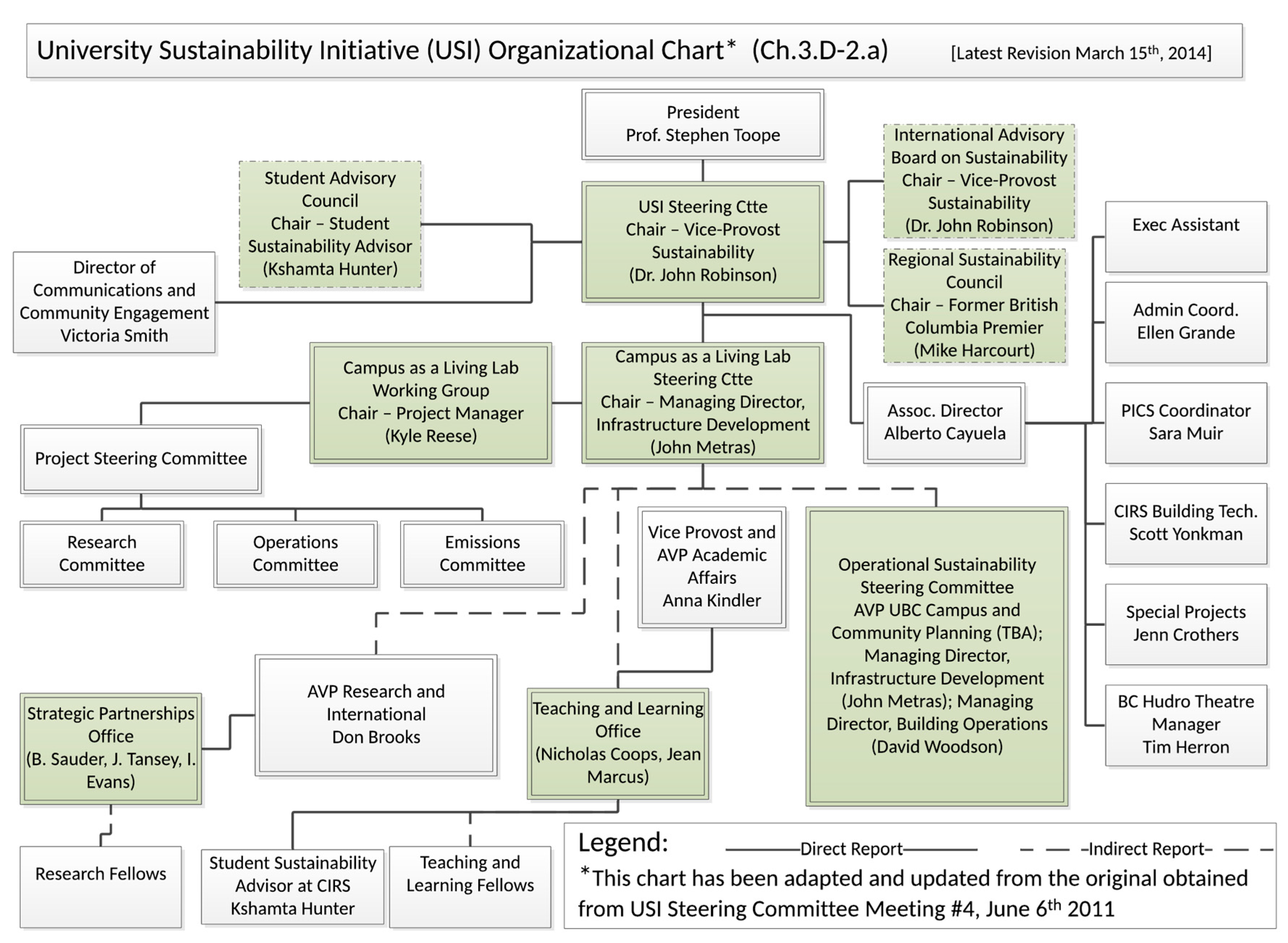
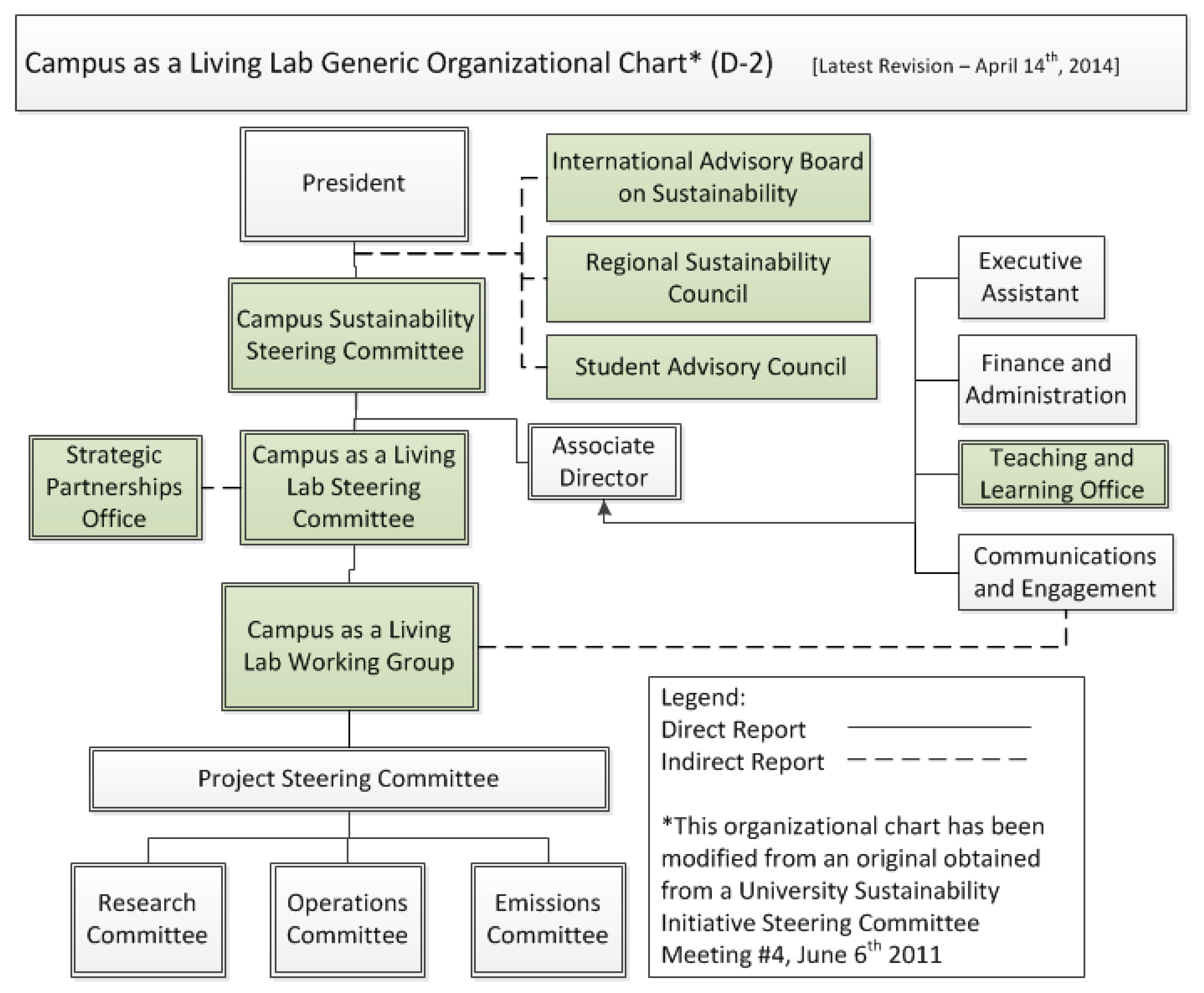
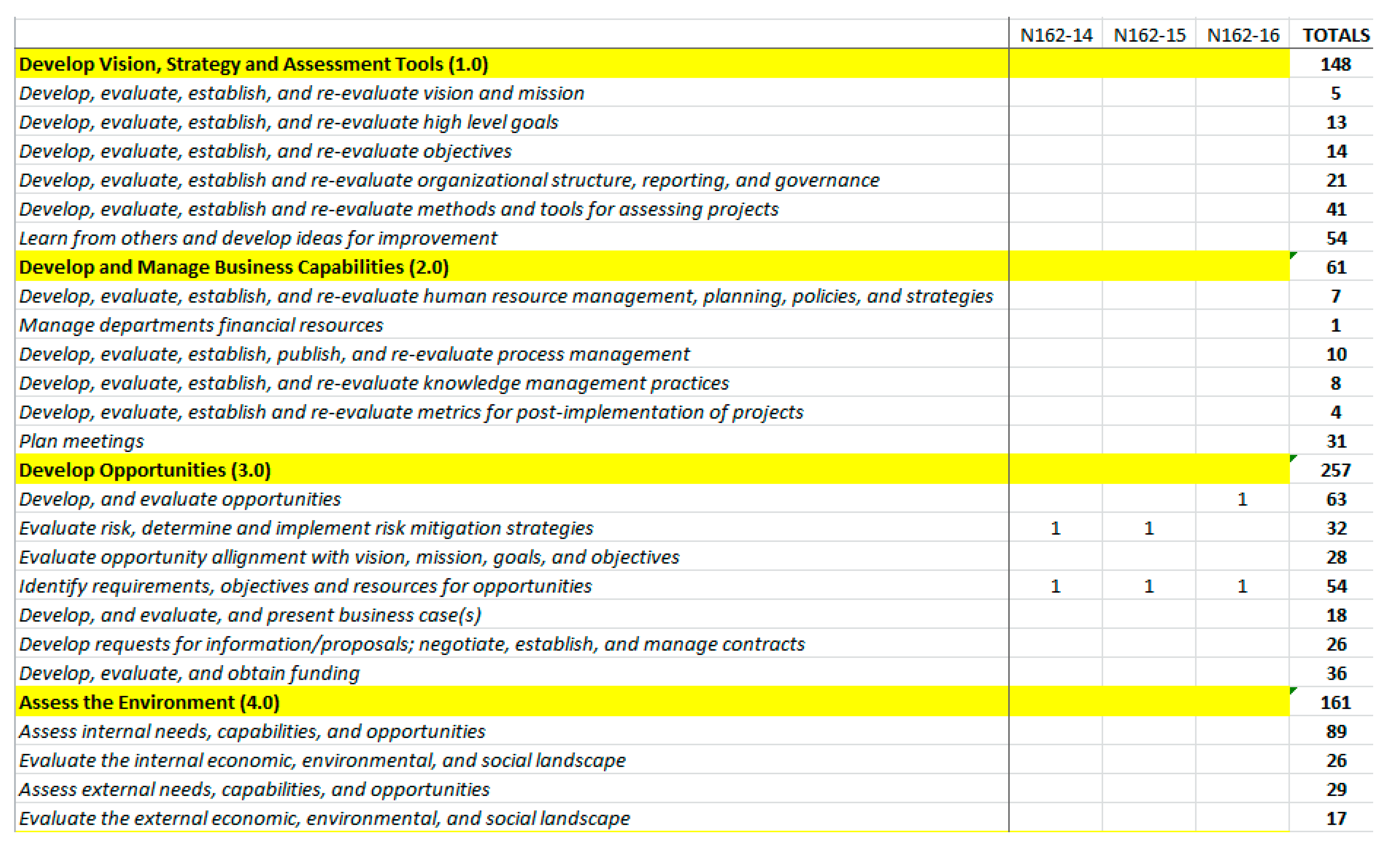
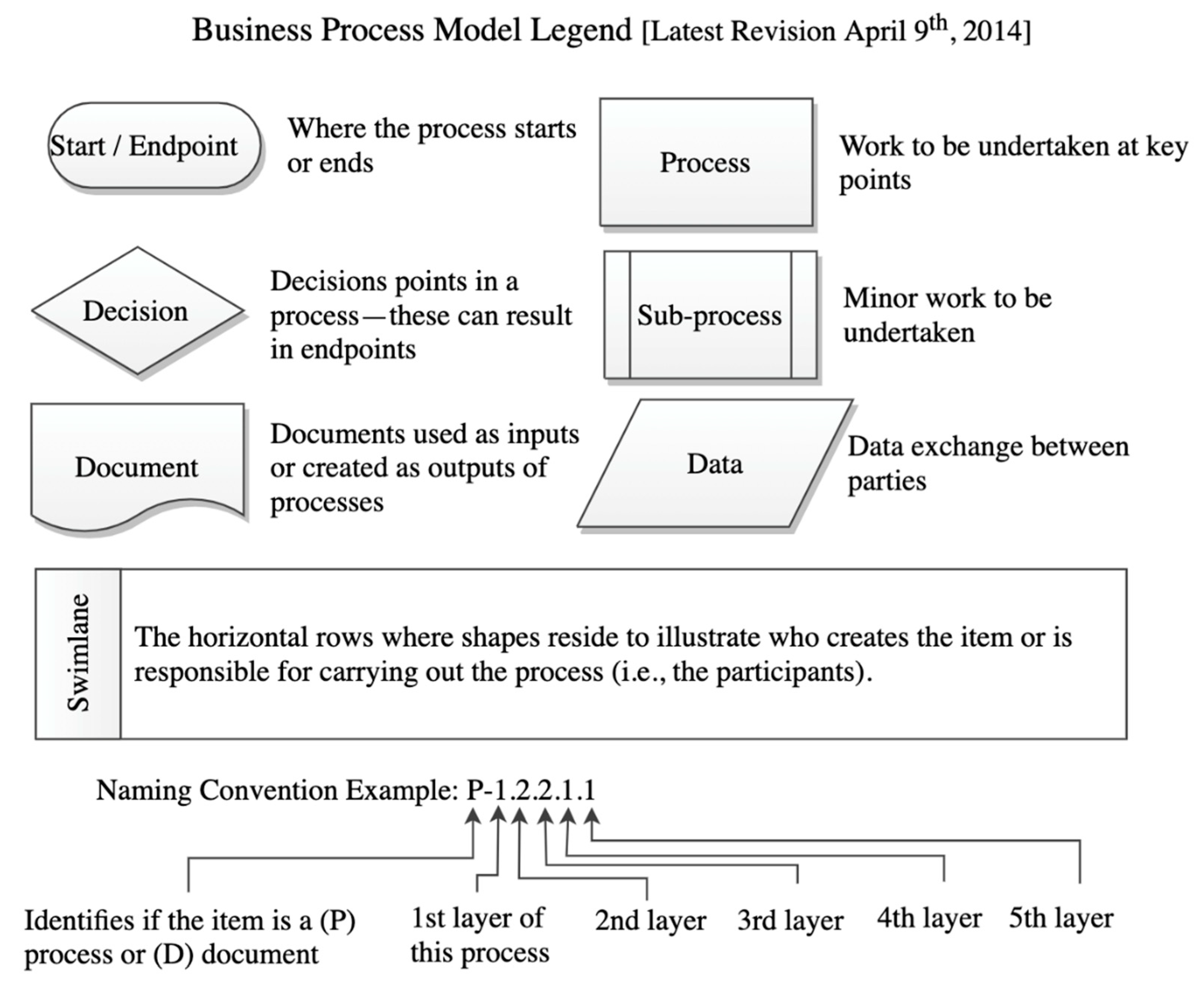
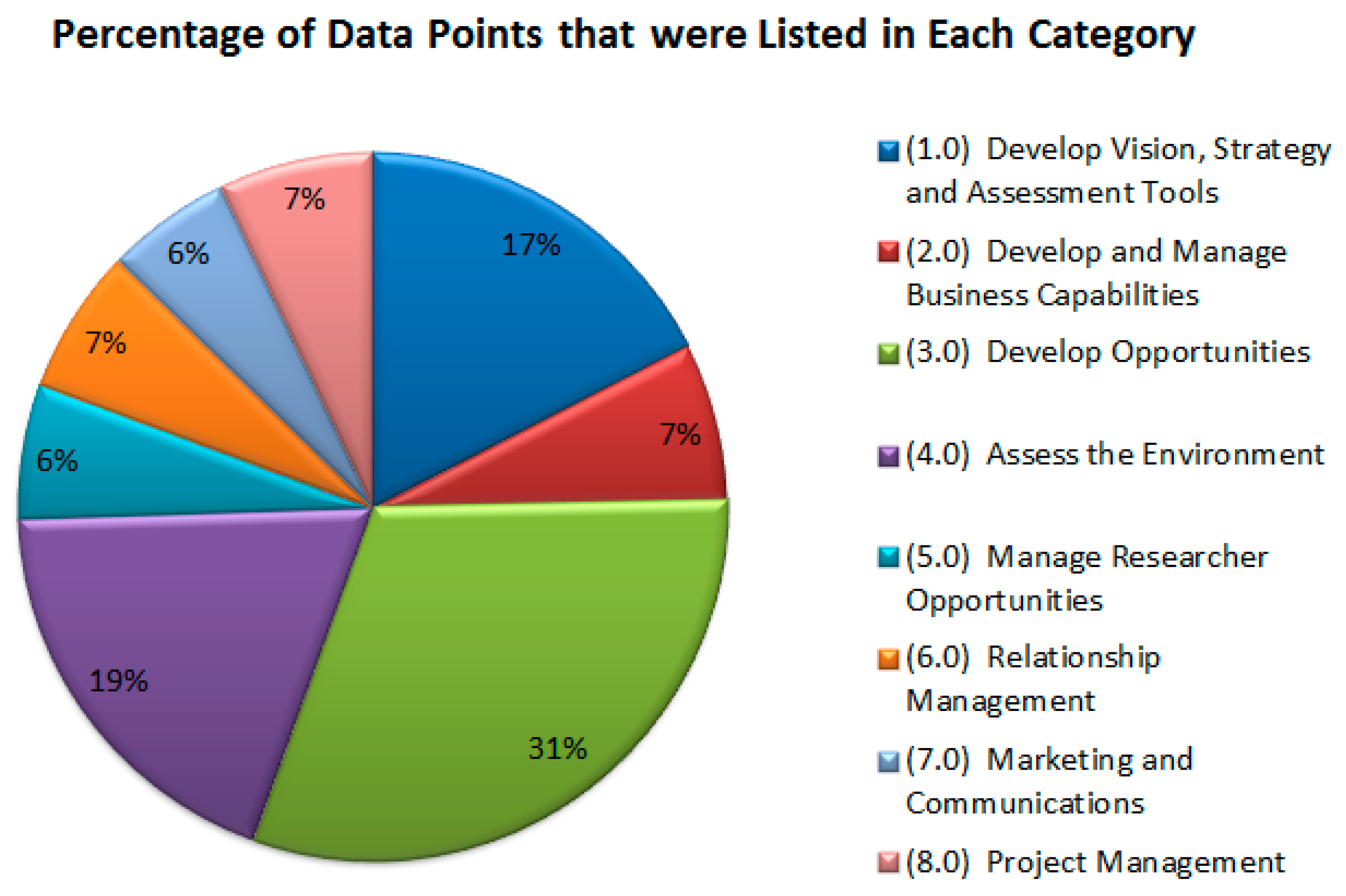
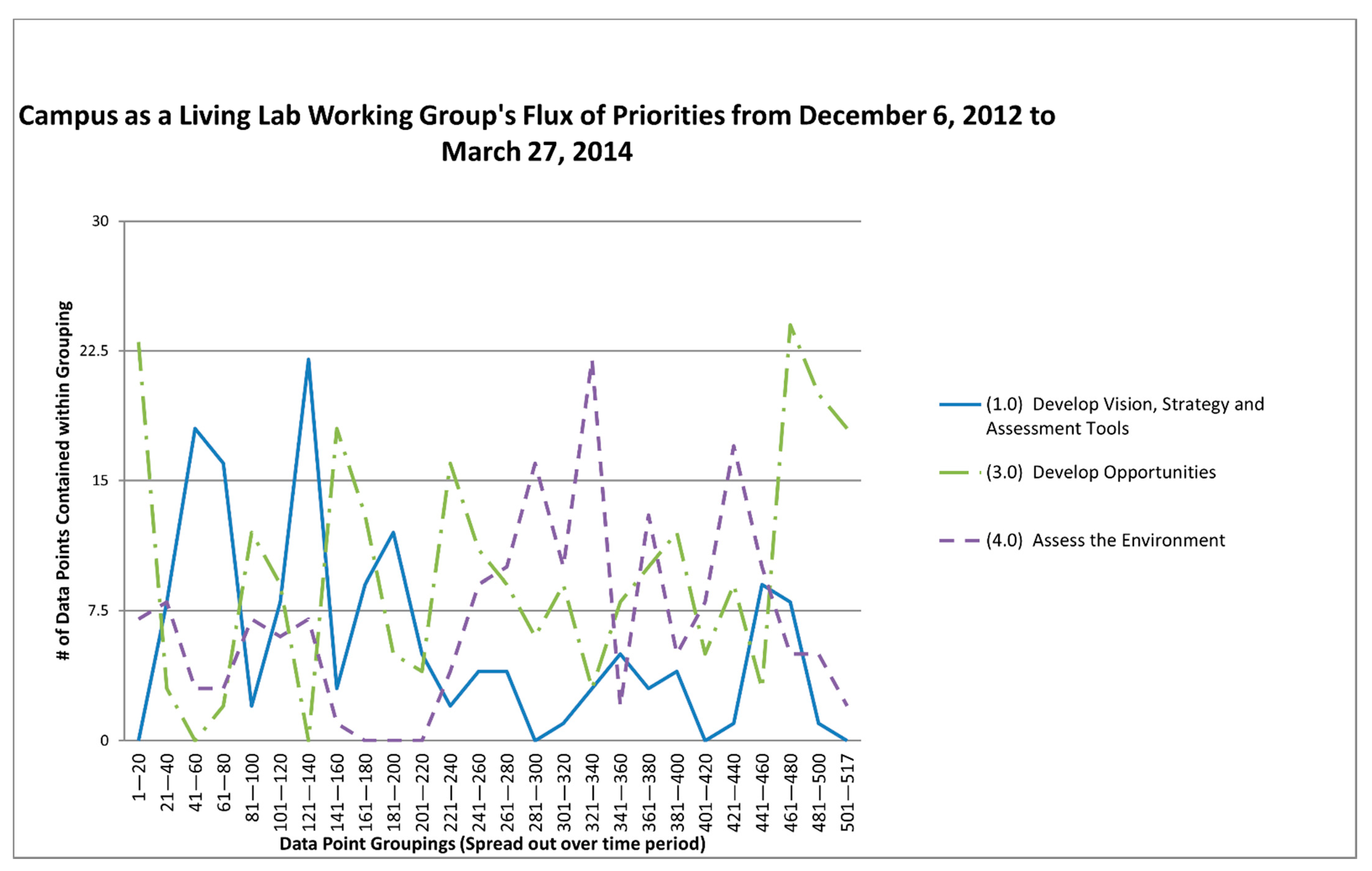
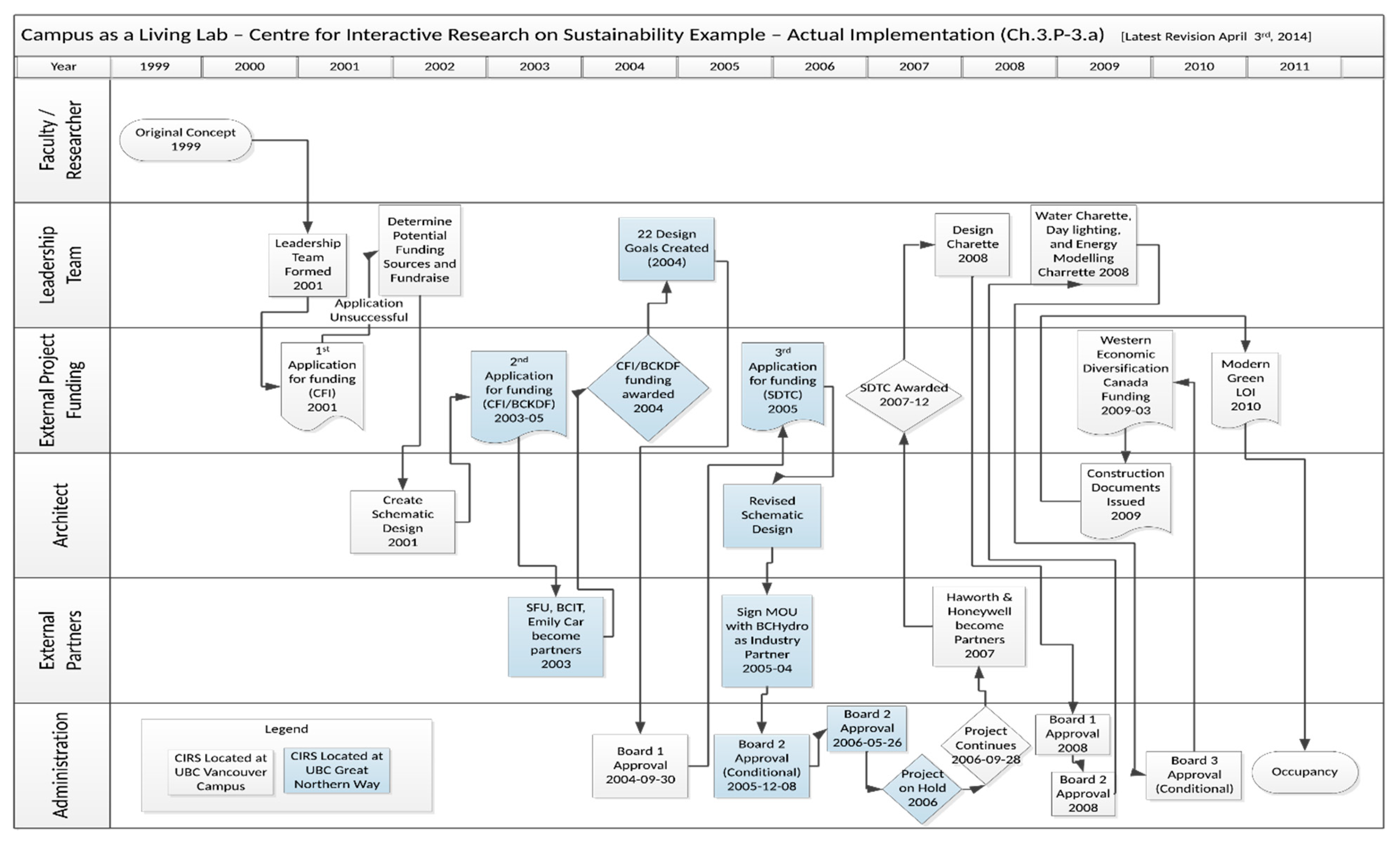
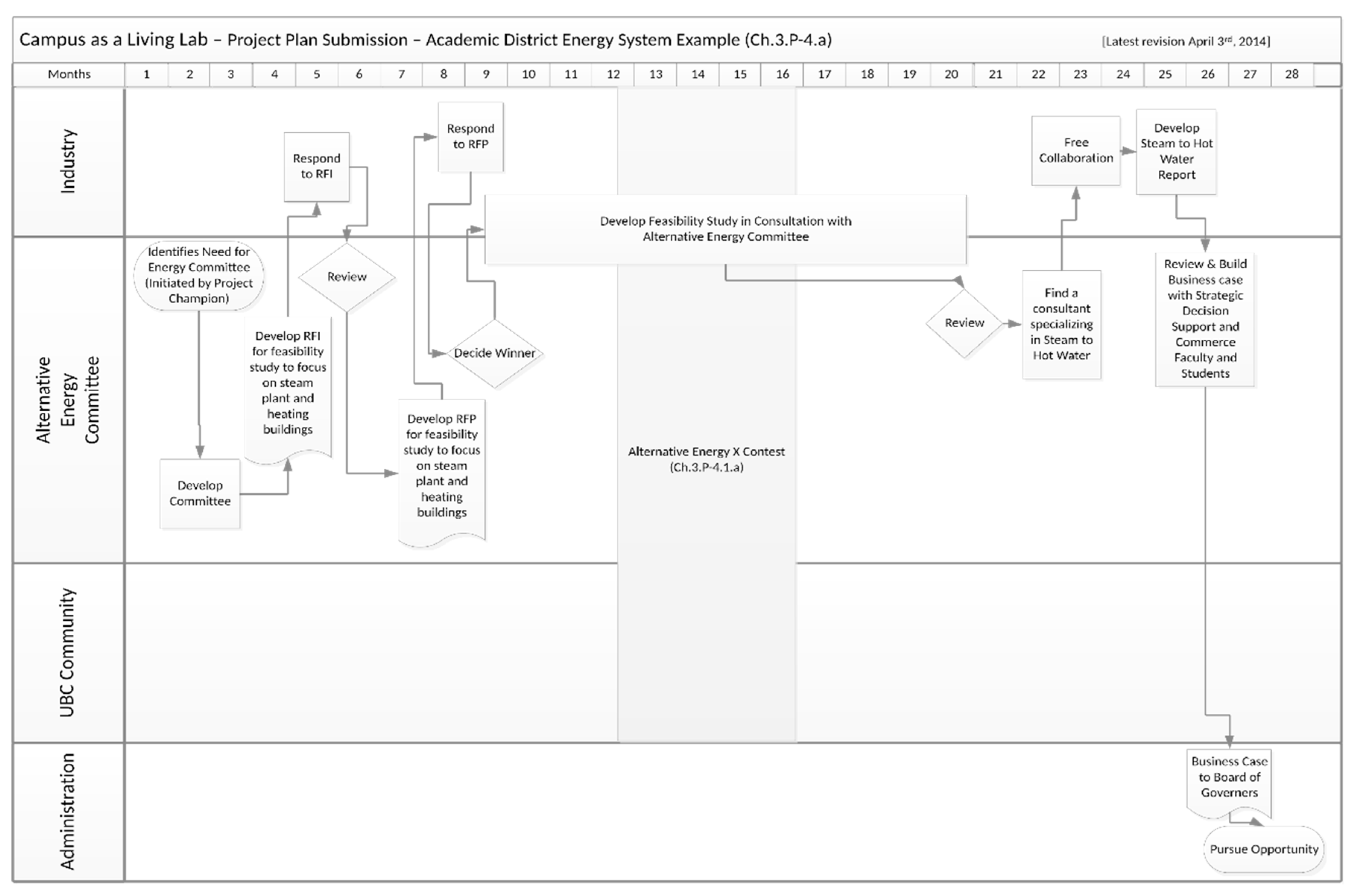
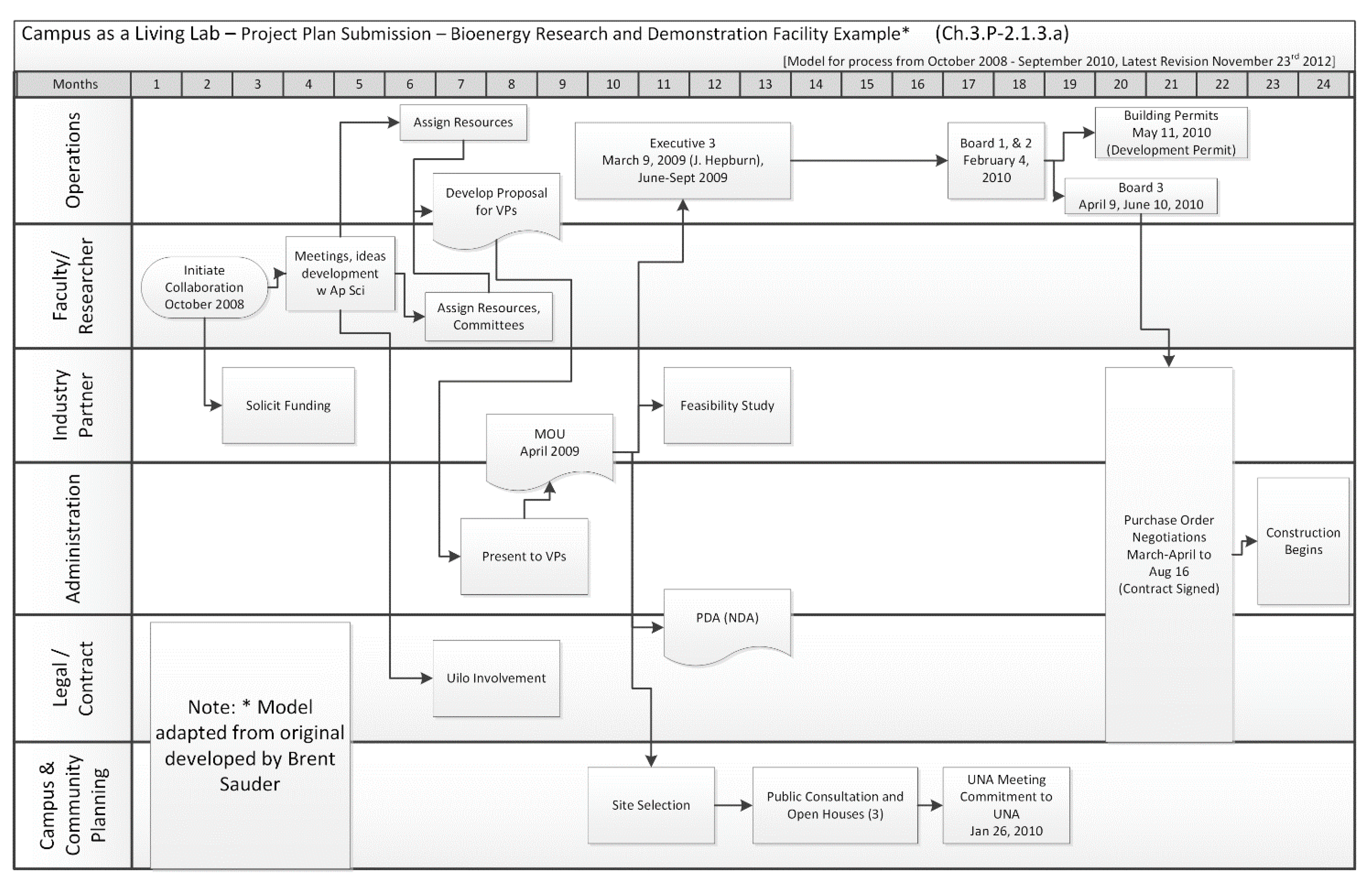
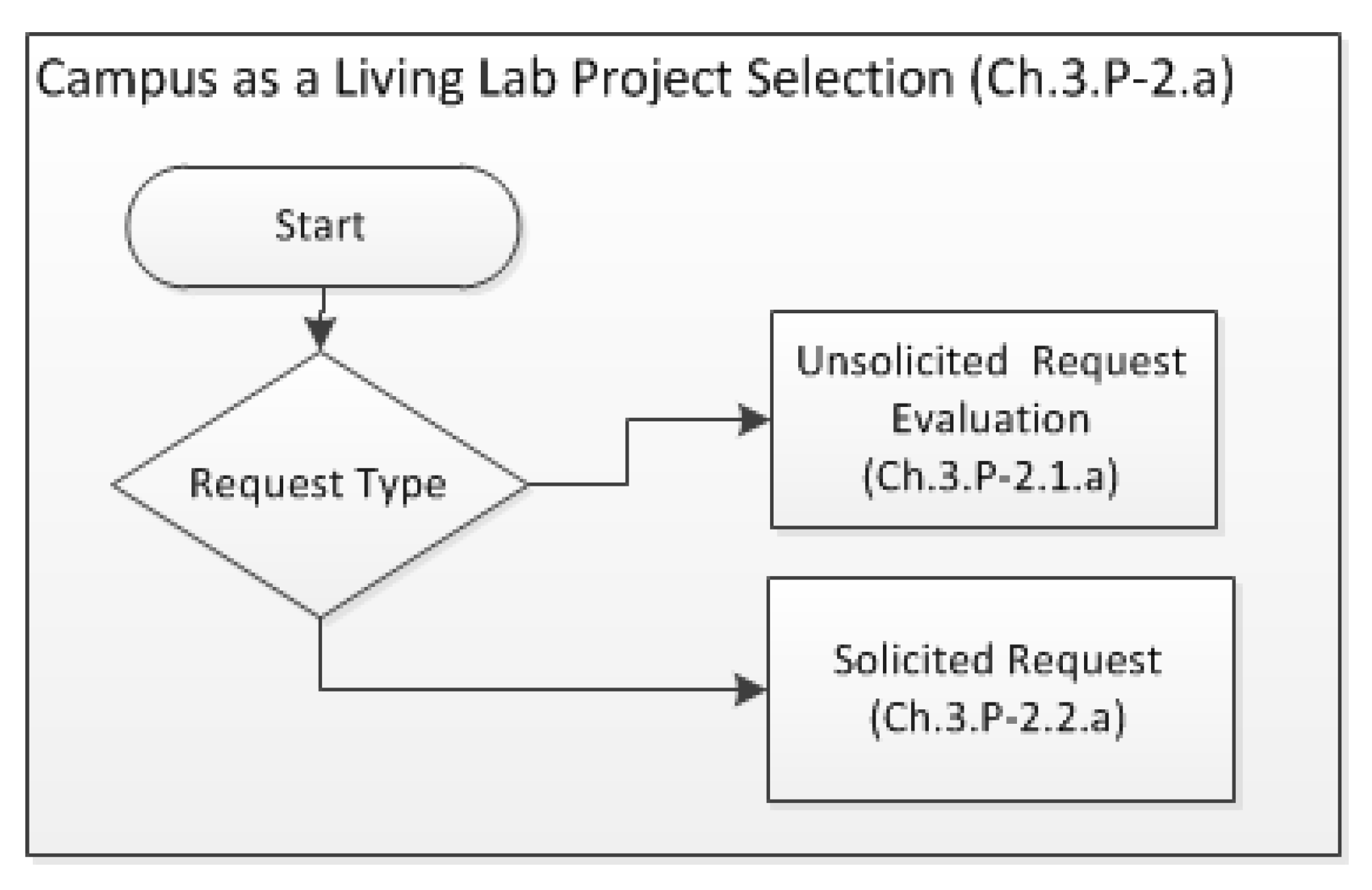
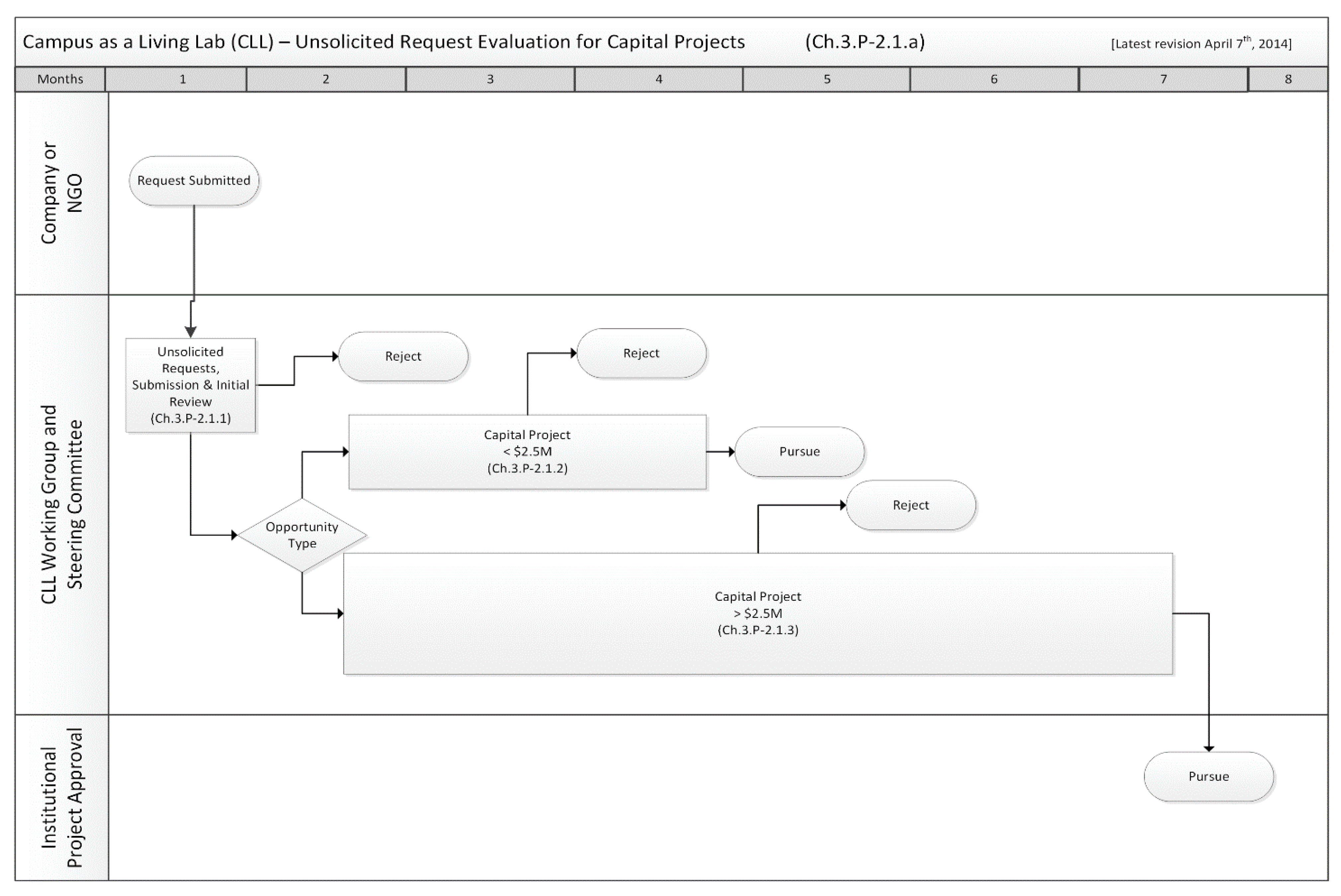
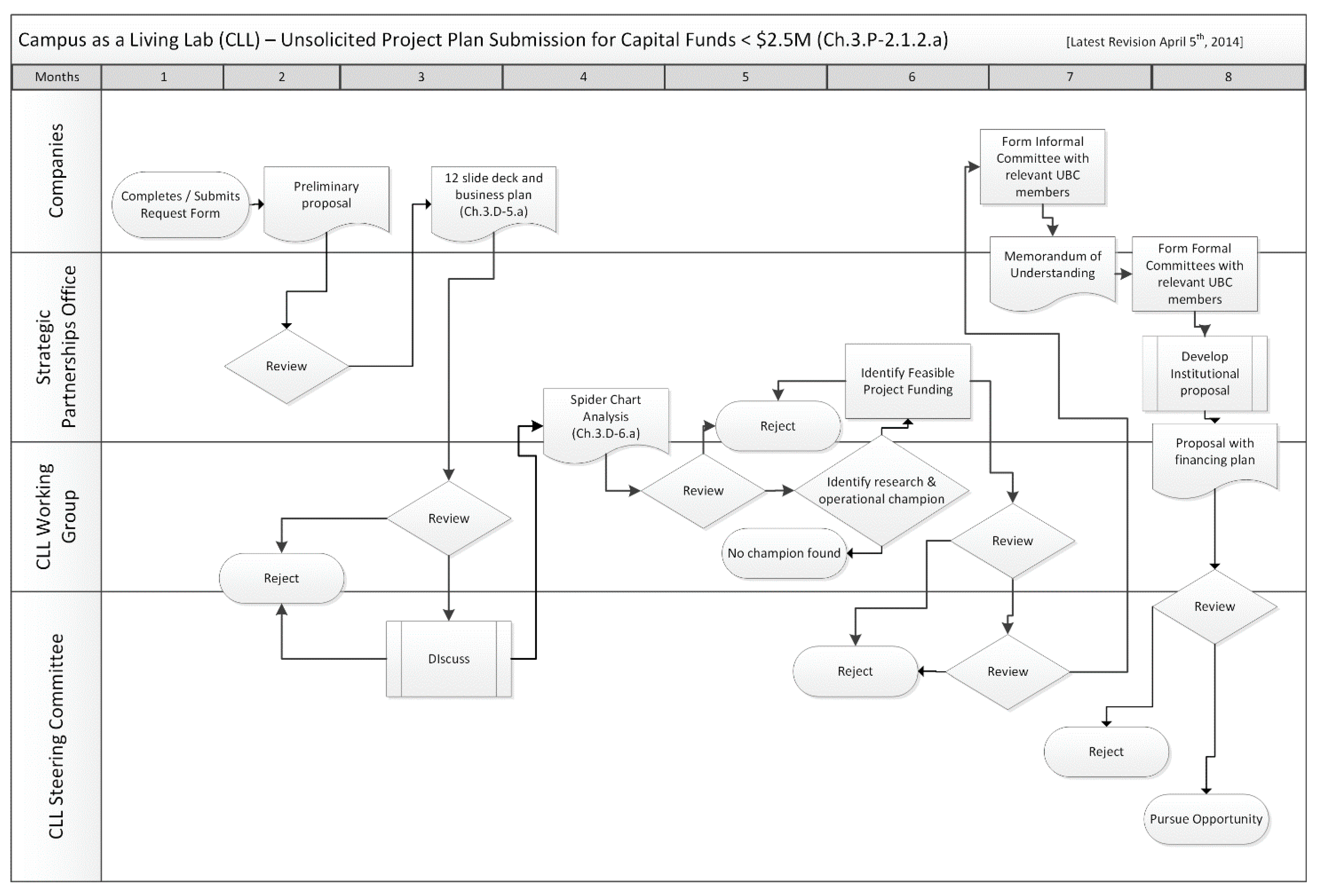
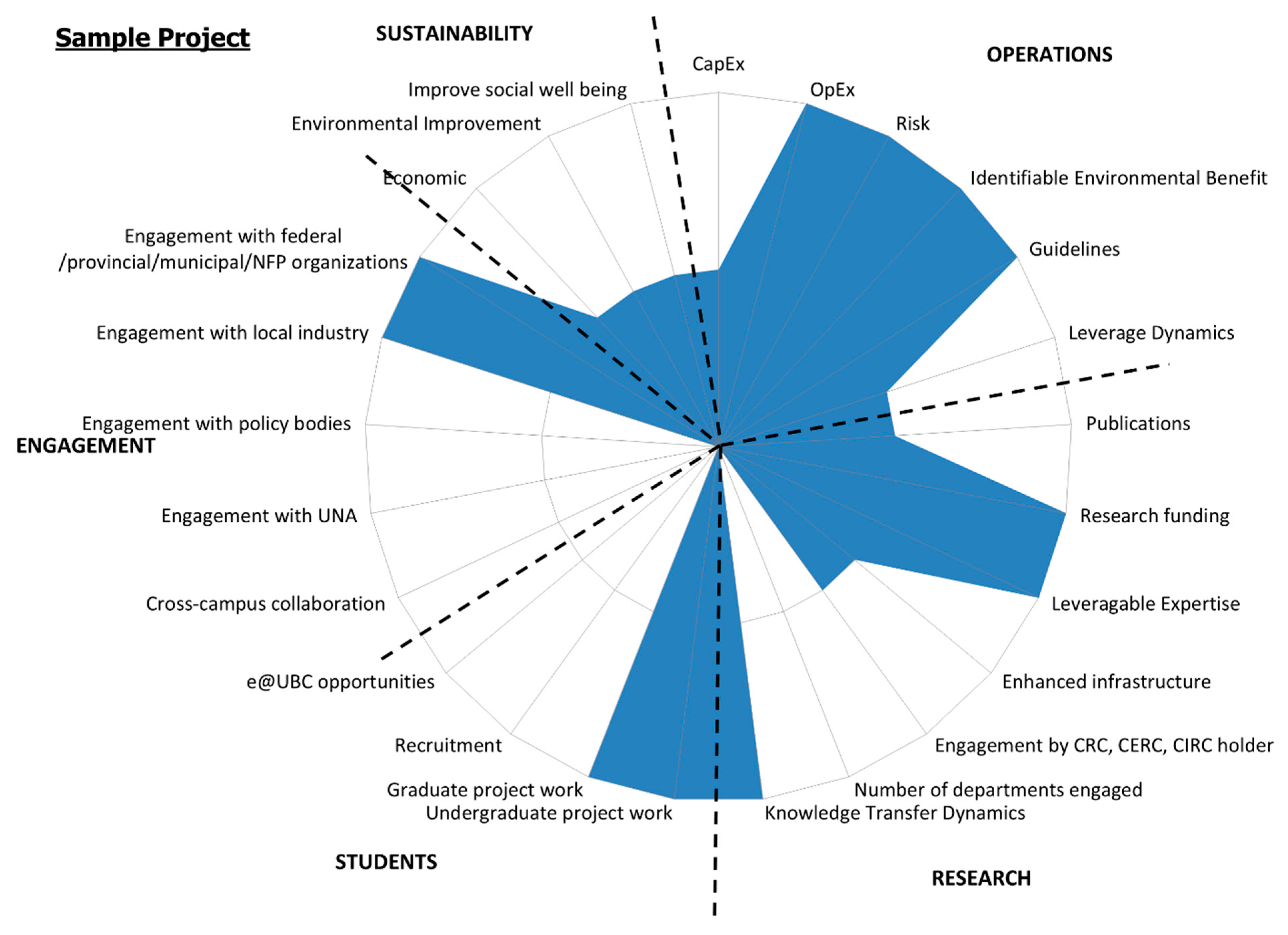
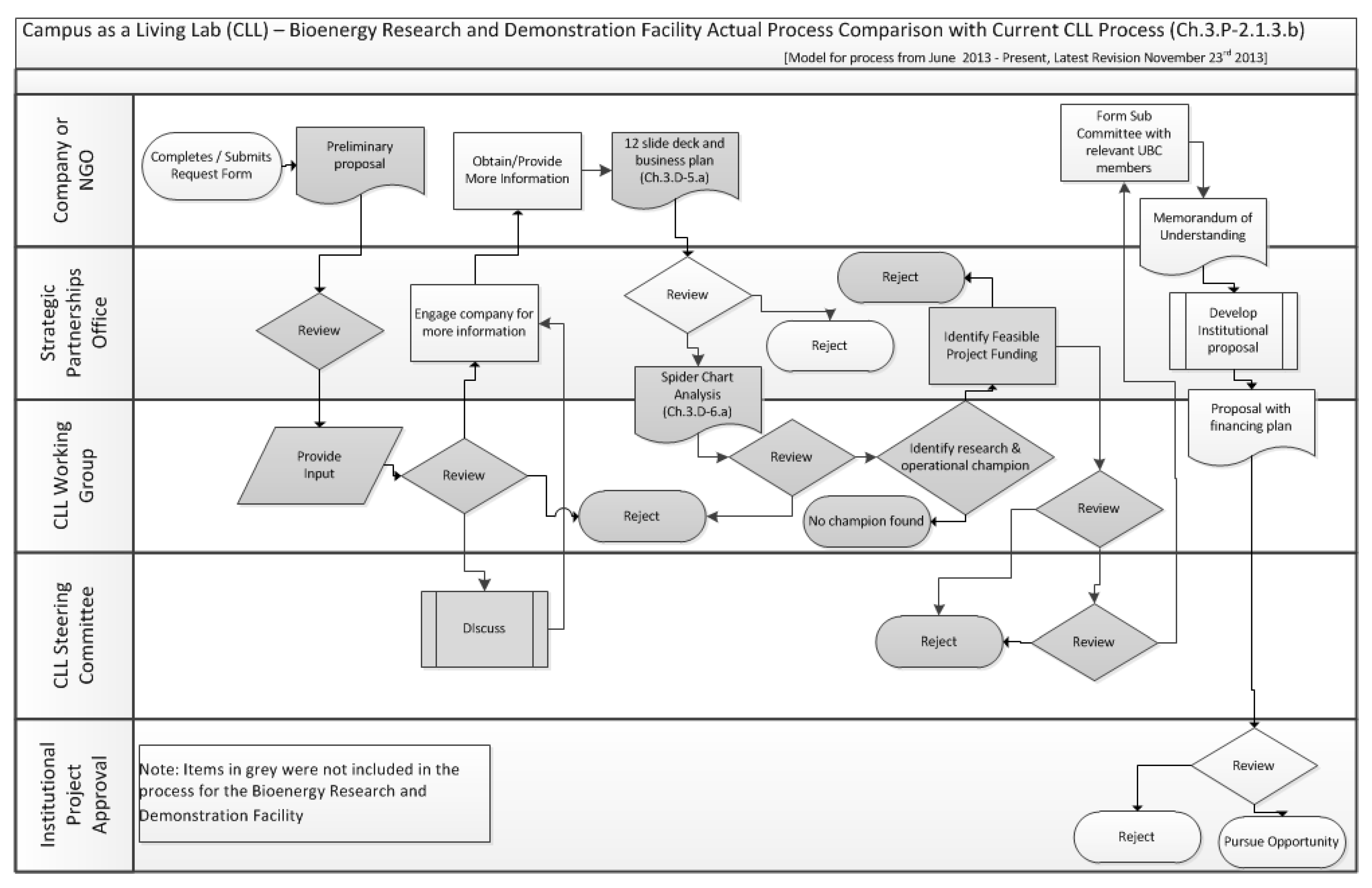
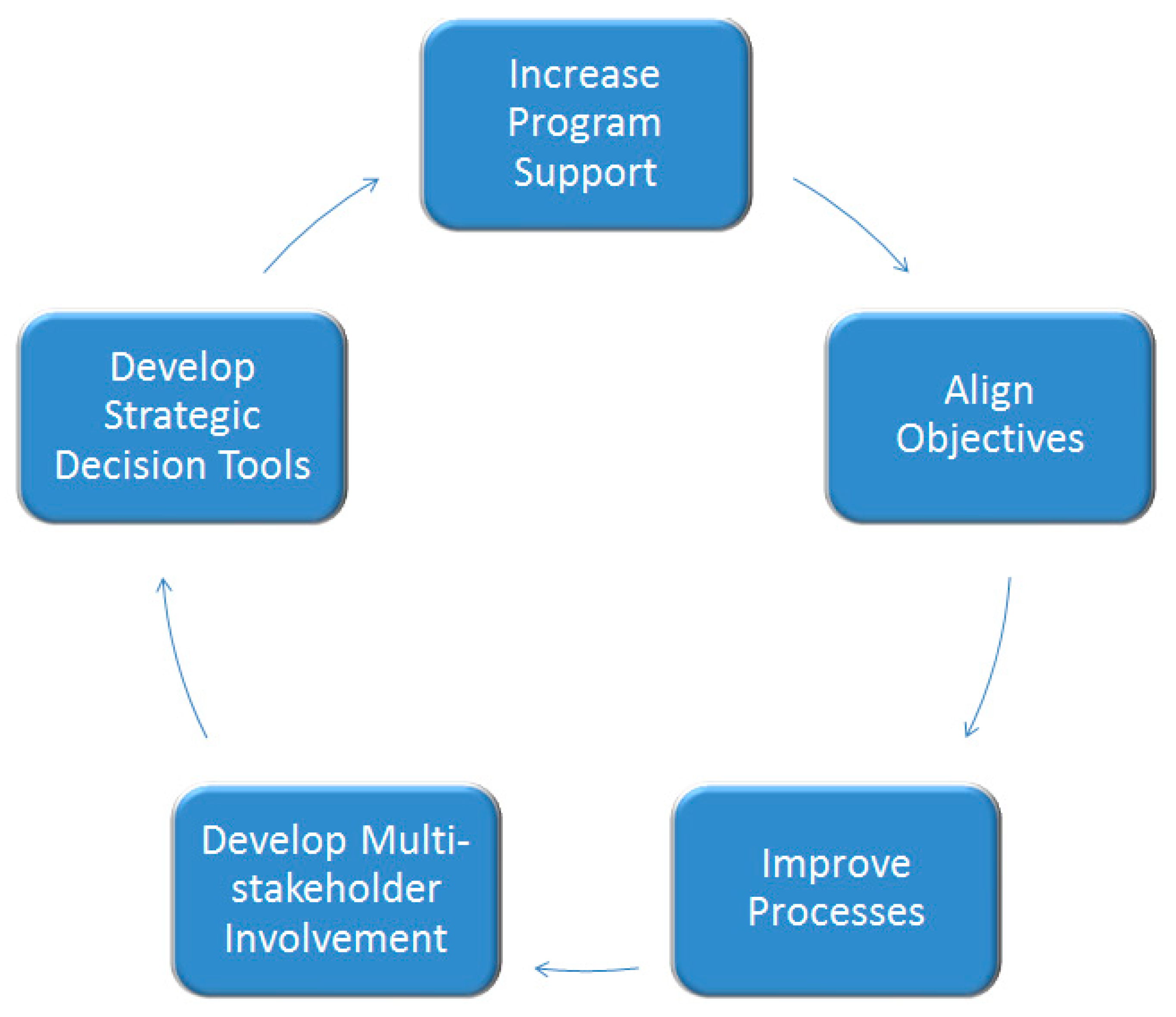
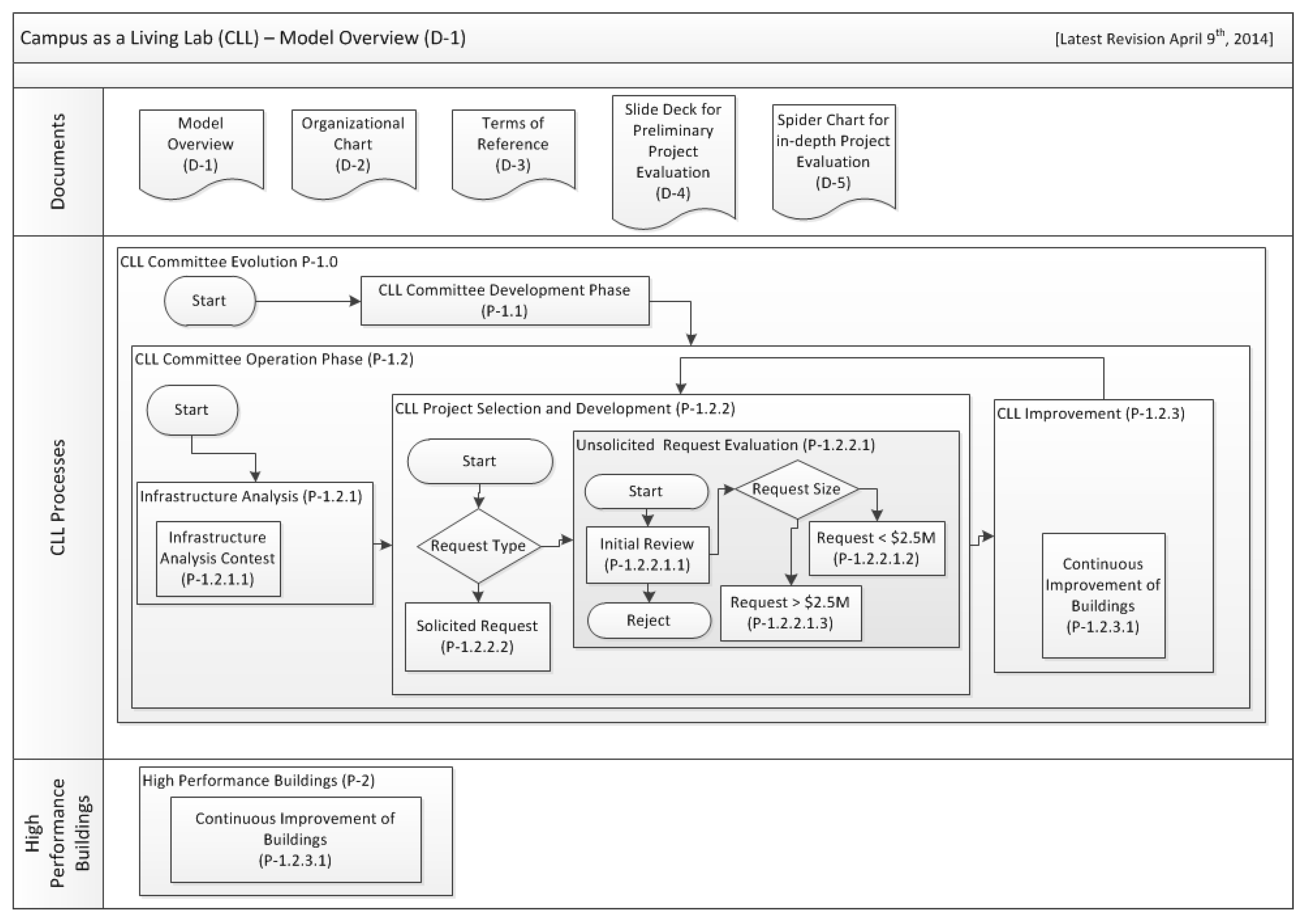
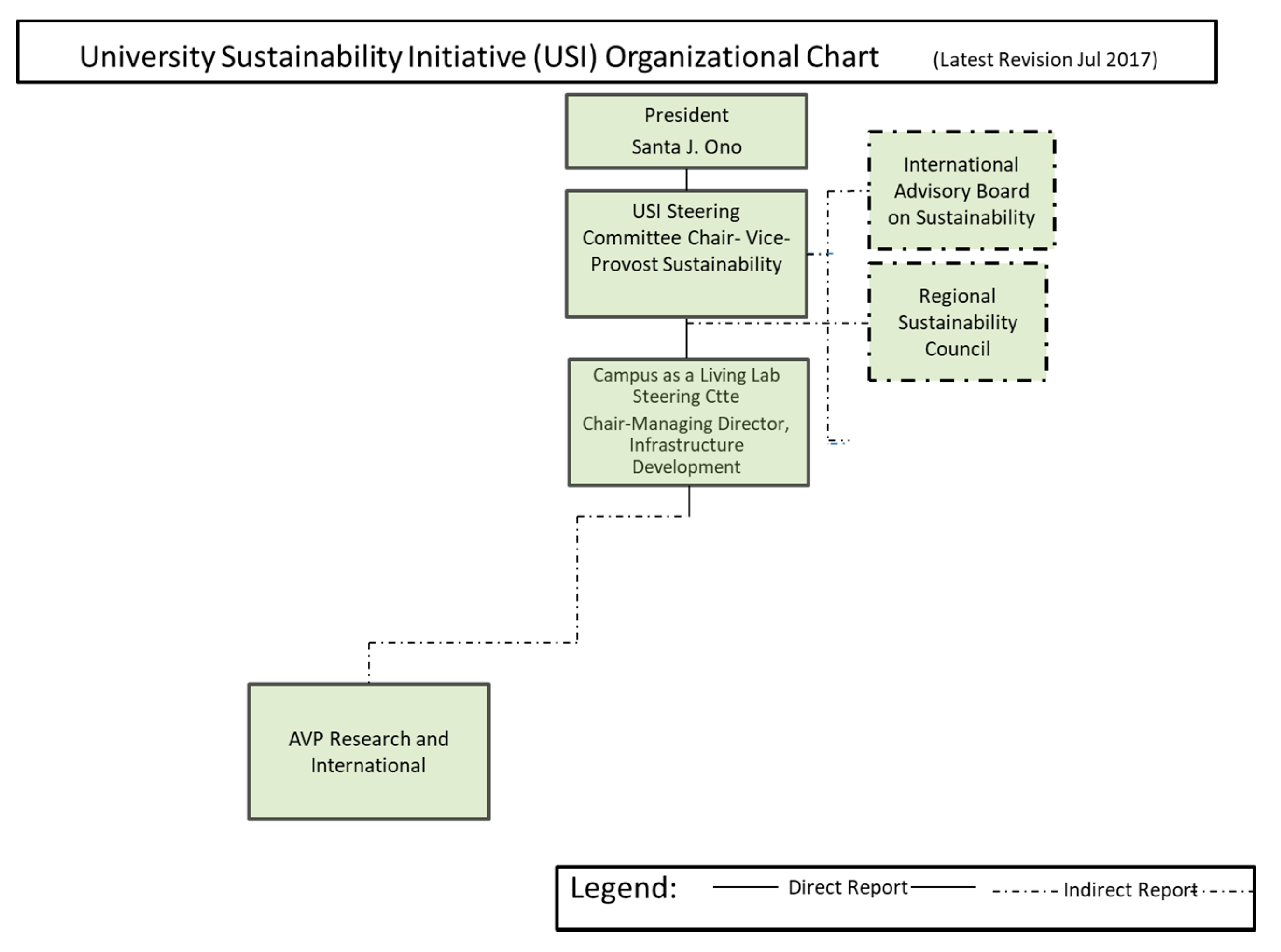
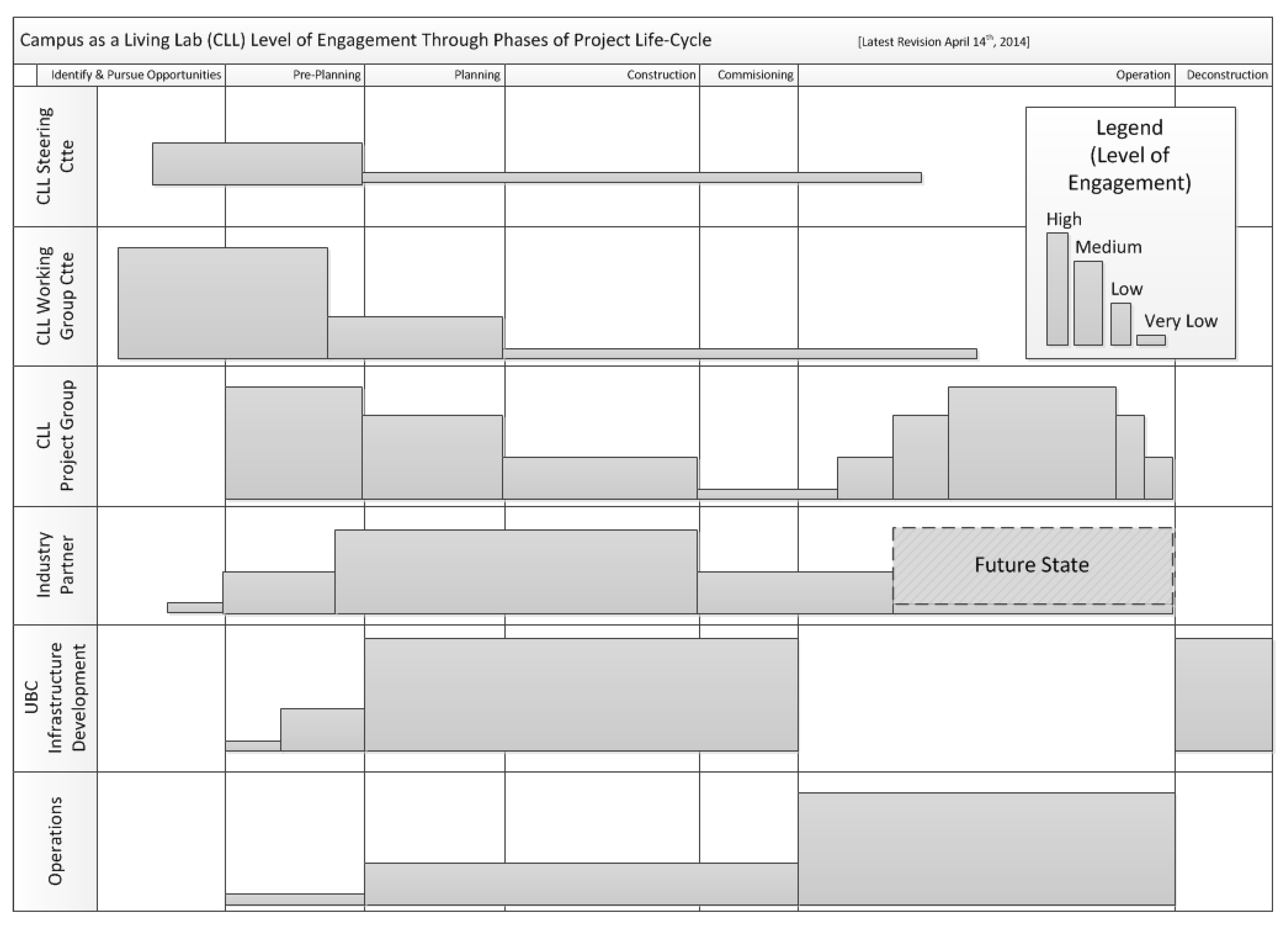
| Slide # & Item | Contents |
|---|---|
| (1) Introduction Slide | Project name, Company name, Company location, Company lead |
| (2) Presentation Outline | Slide headings of 3 to 12 on this list |
| (3) Executive Summary | How UBC helps achieve the company’s corporate goals |
| (4) Opportunity Positioning | The key problem they are solving and why it is unlike any other product |
| (5) Solution Overview | Outlines the value proposition and core technology |
| (6) Solution Example | Describes how problems will be overcome |
| (7) Program Plan | Provides key resources, tasks, and milestones |
| (8) Program Partnerships | Partnerships that will develop within BC and beyond |
| (9) Product Cost Assumptions | A detailed cost breakdown |
| (10) Innovation Opportunities | Researcher involvement opportunities, risks, and barriers to commercialization |
| (12) Operations and Maintenance Support Plan | How support will be provided to UBC |
| (13) Value-added Opportunities | Other potential synergistic opportunities for UBC |
Publisher’s Note: MDPI stays neutral with regard to jurisdictional claims in published maps and institutional affiliations. |
© 2021 by the authors. Licensee MDPI, Basel, Switzerland. This article is an open access article distributed under the terms and conditions of the Creative Commons Attribution (CC BY) license (http://creativecommons.org/licenses/by/4.0/).
Share and Cite
Save, P.; Terim Cavka, B.; Froese, T. Evaluation and Lessons Learned from a Campus as a Living Lab Program to Promote Sustainable Practices. Sustainability 2021, 13, 1739. https://doi.org/10.3390/su13041739
Save P, Terim Cavka B, Froese T. Evaluation and Lessons Learned from a Campus as a Living Lab Program to Promote Sustainable Practices. Sustainability. 2021; 13(4):1739. https://doi.org/10.3390/su13041739
Chicago/Turabian StyleSave, Paul, Belgin Terim Cavka, and Thomas Froese. 2021. "Evaluation and Lessons Learned from a Campus as a Living Lab Program to Promote Sustainable Practices" Sustainability 13, no. 4: 1739. https://doi.org/10.3390/su13041739
APA StyleSave, P., Terim Cavka, B., & Froese, T. (2021). Evaluation and Lessons Learned from a Campus as a Living Lab Program to Promote Sustainable Practices. Sustainability, 13(4), 1739. https://doi.org/10.3390/su13041739






